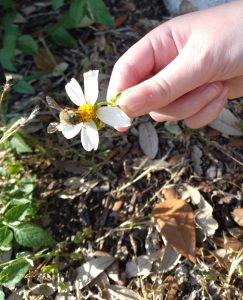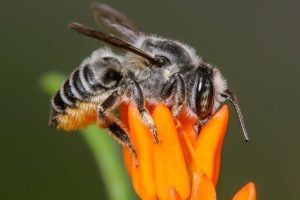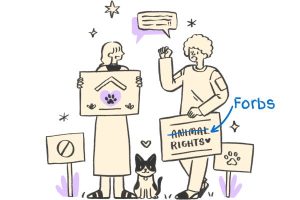
Consider No Mow March
Spring will be upon us before you know it, and with it will come of flurry of growth and activity in our gardens. Our native bees who are responsible for a large portion of pollination duties will emerge and start looking for flowers to forage. In early March, we won’t have reached peak blooming season in our landscapes, but there is something you can do to help the bees find food- wait three weeks to mow or don’t mow at all.
Originally No Mow May
The concept of No Mow May was started in the U.S. by the Bee City affiliate town of Appleton, Wisconsin, in 2020. The city suspended their weed ordinances for the month of May and over 400 residents participated that first year. Here in Florida, No Mow May has been adapted to No Mow March to account for the timing of the native bee emergence in the spring this far south.
 The Freedom Lawn Approach.
The Freedom Lawn Approach.
No Mow or Slow Mow March will work best in landscapes that utilize the freedom lawn approach. A freedom lawn allows whatever forbs and grasses (some people may say weeds) to grow and then mow short to keep them turfgrass height. Starting slow to mow in the spring gives forb lawns time to put on blooms and provide pollen and nectar for our busy foraging friends. These lawns are free from irrigation, fertilizers, insecticides, fungicides, and herbicides. Freedom lawns free up time and money spent on these chemicals and their applications as well.
Mow less: more Wildlife. Mow more: more Pests
 Research has shown that less frequent mowing really does help. A study in Massachusetts found that lawns mowed every three weeks had over twice as many blooming forbs and a higher diversity of bee species. A whopping 111 different bee species were documented during the study. A meta-analysis of many different studies showed an increase in numbers and species of butterflies, bees, grasshoppers, crickets, and true bugs in less frequently mowed lawns. You might not care for the crickets and grasshoppers, but they provide food for our baby bird who hatch in spring as well. In contrast, more manicured lawns had fewer bees and butterflies but more pest insects such as centipedes, millipedes, spiders, ticks, and mites.
Research has shown that less frequent mowing really does help. A study in Massachusetts found that lawns mowed every three weeks had over twice as many blooming forbs and a higher diversity of bee species. A whopping 111 different bee species were documented during the study. A meta-analysis of many different studies showed an increase in numbers and species of butterflies, bees, grasshoppers, crickets, and true bugs in less frequently mowed lawns. You might not care for the crickets and grasshoppers, but they provide food for our baby bird who hatch in spring as well. In contrast, more manicured lawns had fewer bees and butterflies but more pest insects such as centipedes, millipedes, spiders, ticks, and mites.
Neighbors
You may be thinking, “I like bees, butterflies, and baby birds, but what will the neighbors think?” Well, you can download Low Mow Spring yard signs from Bee City USA’s website at beecityusa.og/no-mow-may, and use it as an opportunity to tell them about what you are doing and why. As long as you keep the grass under 15” in height you will stay in the good graces of city code enforcement too.
Perhaps you live in an HOA that dictates a weed-free St. Augustine grass lawn. If this is the case, can you do a mullet landscape? It’s business in the front but a party in the back…yard. Stop treating the backyard with chemicals and let the forbs grow. Even the dandelions that will come up quickly are good for the bees. Why see if you can hold out and observe No Mow March for three weeks?
Source: UF/IFAS Pest Alert
Note: All images and contents are the property of UF/IFAS.




